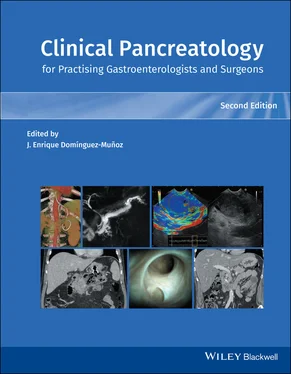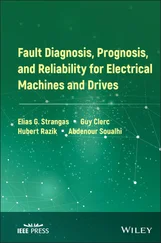Table 1.8 Long‐term sequelae after resolution of acute pancreatitis.
| Chronic pancreatitis Exocrine pancreatic insufficiency Diabetes mellitus Pancreatic ductal adenocarcinoma Decreased quality of life |
Hollemans et al. [101] reported on the follow‐up of almost 1500 patients with AP at 36 months. They found a pooled prevalence of EPI of 27%. Using fecal elastase levels, EPI occurred significantly more often in patients with alcoholic pancreatitis than in those with other etiologies. EPI was significantly more common in patients with severe than mild AP [101]. The presence of pre‐diabetes and/or diabetes mellitus in patients after AP should necessitate a search for coexistent EPI. In patients after AP, Das et al. [102] found a prevalence of concomitant EPI of 40% in patients with newly diagnosed pre‐diabetes or diabetes.
Machicado et al. [103] reported the long‐term deleterious effect on physical health‐related quality of life using a physical‐ and mental health‐related quality of life telephone survey. Individuals who had experienced AP had a significantly lower physical component survey (PCS) score than did controls and this was associated with the presence of multisystem organ failure during hospitalization, which is similar to other ICU survivors. In addition, at time of follow‐up lower PCS scores were associated with abdominal pain, analgesic use, disability, and cigarette use. Thus, support to discontinue smoking and alcohol use and to control pain on discharge should be a focus of ongoing care.
The long‐term (median of 10.5 years) follow‐up of pancreatic function after the first episode of acute alcoholic pancreatitis was reported by Nikkola et al. [104]. As expected, 35% had one or more recurrent episodes of AP during a maximum follow‐up of 13 years. New pancreatogenic diabetes developed in 19%, all of which had recurrent AP. Exocrine pancreatic dysfunction occurred in 77 (24%) patients, which was associated with abnormal endocrine function [104]. In alcoholic patients with RAP, progression to chronic pancreatitis occurred in 19% [104] and in 38% mainly in alcoholics as reported by Lankisch et al. [105].
The risk of pancreatic cancer after a primary episode of AP was reported by Rijkers et al. [106] in 731 patients who were followed for a median of 55 months. Pancreatic cancer incidence rate (per 1000 patient‐years) in the group who progressed to chronic pancreatitis was 9.0 compared with 1.1 in those did not progress to chronic pancreatitis. The median time to developing pancreatic cancer was 47 months in those with chronic pancreatitis and 12 months in those who did not have chronic pancreatitis. One wonders if the AP was secondary to the underlying pancreatic cancer in this group without chronic pancreatitis. No comparative group was utilized in this study [106].
Sadr‐Azodi et al. [107] performed a population‐based cohort study including all Swedish residents diagnosed with AP in order to determine the relationship between AP and pancreatic cancer. Approximately 70% of patients with pancreatic cancer had a history of AP. The risk of pancreatic cancer was increased during the first few years after the episode of AP and then gradually declined. The risk of pancreatic cancer between two months and two years after hospitalization for AP was highest in individuals aged 60 and above without gallstone‐related pancreatitis but with diabetes mellitus. Those cancers diagnosed within six months of AP were more likely to be localized [107].
A follow‐up, nationwide, matched cohort study from Denmark by Kirkegard et al. [108] found that patients with AP had increased risk of pancreatic cancer. Their risk for developing pancreatic cancer decreased with time but was still elevated at two and five years post episode and this included a three‐year washout period to reduce the likelihood of including prevalent cases of pancreatic cancer. Thus, we must continue to follow up and search for an underlying neoplasm in patients with AP who are older than 40 years of age, irrespective of the presumed cause of their AP. The reason(s) for this association may be similar etiologies, including alcohol, smoking, diet, diabetes, and obesity [109].
Thus, patients with a history of AP regardless of cause should likely undergo screening for pancreatic cancer in the five years after their initial episode.
1 1 Gapp J, Hall AG, Walters RW, et al. Trends and outcomes of hospitalizations related to acute pancreatitis. Epidemiology from 2001 to 2014 in the United States. Pancreas 2019; 48(4):548–554.
2 2 Afghani E, Pandol SJ, Shimosegawa T, et al. Acute pancreatitis: progress and challenges. A report on an international symposium. Pancreas 2015; 44:1195–1210.
3 3 Roberts SE, Morrison‐Rees S, John A, et al. The incidence and etiology of acute pancreatitis across Europe. Pancreatology 2017; 17:155–165.
4 4 Brindise E, Elkhatib I, Kuruvilla A, Silva R. Temporal trends in incidence and outcomes of acute pancreatitis in hospitalized patients in the United States. Pancreas 2019; 48:169–175.
5 5 Krishna SG, Kamboj AK, Hart PA, et al. The changing epidemiology of acute pancreatitis hospitalizations: a decade of trends and the impact of chronic pancreatitis. Pancreas 2017; 46:482–488.
6 6 Peery AF, Crockett SD, Murphy CC, et al. Burden and cost of gastrointestinal, liver and pancreatic diseases in the United States: Update 2018. Gastroenterology 2019; 156:254–272.
7 7 Barkin JA, Nemeth Z, Saluja AK, Barkin JS. Cannabis‐induced acute pancreatitis: a systematic review. Pancreas 2017; 46:1035–1038.
8 8 Ardengh JC, Malheiros CA, Rahl F, et al. Microlithiasis of the gallbladder: role of endoscopic ultrasonography in patients with idiopathic pancreatitis. Rev Assoc Med Bras 2010; 56(1):27–31.
9 9 Vila JJ. Endoscopic ultrasonography and idiopathic acute pancreatitis. World J Gastrointest Endosc 2010; 2:107–111.
10 10 Andriulli A, Loperfido S, Napolitano G, et al. Incidence rates of post‐ERCP complications: a systematic survey of prospective studies. Am J Gastroenterol 2007; 102:1781–1788.
11 11 Cotton PB, Garrow DA, Gallagher J, Romagnuolo J. Risk factors for complications after ERCP: a multivariate analysis of 11,497 procedures over 12 years. Gastrointest Endosc 2009; 70:80–88.
12 12 Buxbaum JL, Abbas Fehmi SM, Sultan S, et al. ASGE guideline on the role of endoscopy in the evaluation and management of choledocholithiasis. Gastrointest Endosc 2019; 89(6):1075–1105.e15.
13 13 De Lisi S, Leandro G, Buscarini E. Endoscopic ultrasonography versus endoscopic retrograde cholangiopancreatography in acute biliary pancreatitis: a systematic review. Eur J Gastroenterol Hepatol 2011; 23:367–374.
14 14 Makary MA, Duncan MD, Harmon JW, et al. The role of magnetic resonance cholangiography in the management of patients with gallstone pancreatitis. Ann Surg 2005; 241:119–124
15 15 Wan J, Ouyang Y, Yu C, et al. Comparison of EUS with MRCP in idiopathic acute pancreatitis: a systematic review and meta‐analysis. Gastrointest Endosc 2018; 87:1180–1188.
16 16 Wilcox CM, Varadarajulu S, Eloubeidi M. Role of endoscopic evaluation in idiopathic pancreatitis: a systematic review. Gastrointest Endosc 2006; 63:1037–1045.
17 17 Kondo S, Isayama H, Akahane M, et al. Detection of bile duct stones: comparison between endoscopic ultrasonography, magnetic resonance cholangiography and helical‐computed‐tomography cholangiography. Eur J Radiol 2005; 54:271–275.
18 18 Savides TJ. EUS‐guided ERCP for patients with intermediate probability for choledocholithiasis: is it time for all of us to start doing this? Gastrointest Endosc 2008; 67:669–672.
19 19 Khatua B, El Kurdi B, Singh VP. Obesity and pancreatitis. Curr Opinion Gastroenterol 2017; 33:374–382.
Читать дальше












